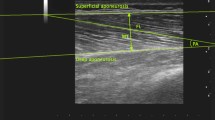Abstract
This study aimed to test the validity and reliability of an extended-field-of-view ultrasonography (EFOV) method for quadriceps muscle cross-sectional area (CSA) assessment. The CSA was measured at 10, 20, 30, 40 and 50% of the distance from the superior border of the patella to the medial aspect of anterior superior iliac spine by EFOV imaging and compared to the CSA measured by computed tomography (CT). Validity was tested by intra-class correlation (ICC) between the two methods and intra- and inter-experimenter and inter-day reliability were also examined. The ICC computed between the two techniques ranged between 0.951 and 0.998 (P < 0.000), but the 95% confidence intervals of the ICCs were in the acceptable range only for 30, 40 and 50% sections (0.842–0.999, 0.943–0.997 and 0.992-0.999, respectively). The standard error of the EFOV technique when compared to CT was 2.4, 4.3, 1.2, 1.2 and 0.6%, for 10, 20, 30, 40 and 50% sections, respectively. The coefficient of variation, showing intra- and inter-experimenter reliability, ranged from 0.6 to 2.7%. ICCs computed to assess the inter-day reliability were between 0.982 and 0.998 (95% confidence interval 0.892–1). When CSA was compared between sections statistically significant differences were found between them, regardless of the imaging technique used. Small standard errors of the measurement and high ICCs with the small confidence intervals suggest that, at proximal and mid-thigh sections, EFOV is a valid and reliable method to measure quadriceps muscle size.






Similar content being viewed by others
References
Aagaard P, Andersen JL, Dyhre-Poulsen P, Leffers A-M, Wagner A, Magnusson SP, Halkjaer-Kristensen J, Simonsen EB (2001) A mechanism for increased contractile strength of human pennate muscle in response to strength training: changes in muscle architecture. J Physiol 534(2):613–623
Ahtiainen JP, Hoffren M, Hulmi JJ, Pietikäinen M, Mero AA, Avela J, Häkkinen K (2010) Panoramic ultrasonography is a valid method to measure changes in skeletal muscle cross-sectional area. Eur J Appl Physiol 108(2):273–279
Bamman MM, Newcomer BR, Larson-Meyer DE, Weinsier RL, Hunter GR (2000) Evaluation of the strength-size relationship in vivo using various muscle size indices. Med Sci Sports Exerc 32(7):1307–1313
Berg HE, Tedner B, Tesch PA (1993) Changes in lower limb muscle cross-sectional area and tissue fluid volume after transition from standing to supine. Acta Physiol Scand 148:379–385
Blazevich AJ, Coleman DR, Horne S, Cannavan D (2009) Anatomical predictors of maximum isometric and concentric knee extensor moment. Eur J Appl Physiol 105(6):869–878
Fornage BD, Atkinson EN, Nock LF, Jones PH (2000) US with extended field of view: phantom-tested accuracy of distance measurements. Radiology 214(2):579–584
Häkkinen K, Pakarinen A, Hannonen P, Häkkinen A, Airaksinen O, Valkeinen H, Alen M (2002) Effects of strength training on muscle strength, cross-sectional area, maximal electromyographic activity, and serum hormones in premenopausal women with fibromyalgia. J Rheumatol 29(6):1287–1295
Kim SH, Choi BI, Kim KW, Lee KH, Han JK (2003) Extended field-of-view sonography. Advantages in abdominal applications. J Ultrasound Med 22:385–394
Reeves ND, Maganaris CN, Narici MV (2004) Ultrasonographic assessment of human skeletal muscle size. Eur J Appl Physiol 91:116–118
Seynnes OR, de Boer M, Narici MV (2007) Early skeletal muscle hypertrophy and architectural changes in response to high-intensity resistance training. J Appl Physiol 102:368–373
Sipilä S, Suominen H (1991) Ultrasound imaging of the quadriceps muscle in elderly athletes and untrained men. Muscle Nerve 14:527–533
Weng L, Tirumalai AP, Lowery CM, Nock LF, Gustafson DE, Von Behren PL, Kim JH (1997) US extended-field-of-imaging technology. Radiology 203:877–880
Conflict of interest statement
Authors had no conflict of interest.
Author information
Authors and Affiliations
Corresponding author
Additional information
Communicated by Arnold de Haan.
Rights and permissions
About this article
Cite this article
Noorkoiv, M., Nosaka, K. & Blazevich, A.J. Assessment of quadriceps muscle cross-sectional area by ultrasound extended-field-of-view imaging. Eur J Appl Physiol 109, 631–639 (2010). https://doi.org/10.1007/s00421-010-1402-1
Accepted:
Published:
Issue Date:
DOI: https://doi.org/10.1007/s00421-010-1402-1




